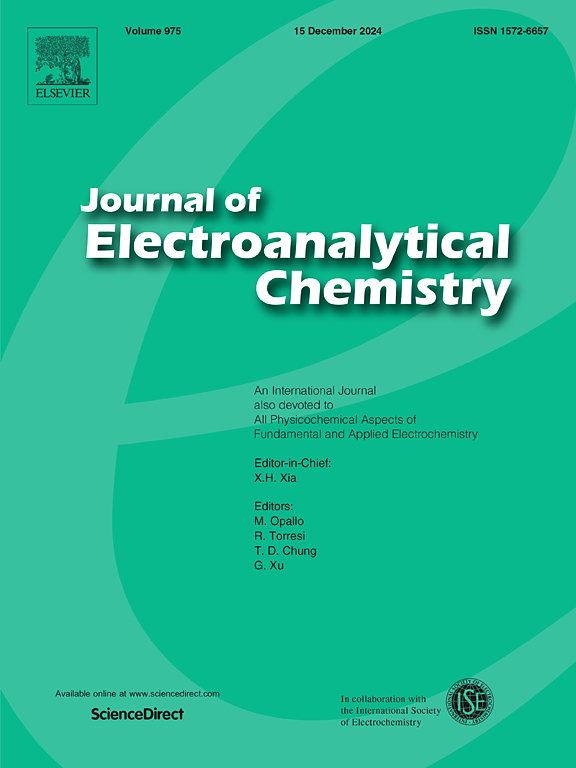An insight into synergistic effects of In2O3 and ZnO nanoparticles co-deposited on TiO2 nanotubes for a photoanode with enhanced photoelectrochemical performance
IF 4.1
3区 化学
Q1 CHEMISTRY, ANALYTICAL
引用次数: 0
Abstract
In this work, titanium dioxide nanotubes (TNTs) were successfully synthesized through a simple one-step electrochemical anodization process. To enhance their functionality, zinc oxide and indium oxide nanoparticles were subsequently deposited onto the TNTs using a chemical bath deposition (CBD) method. This approach aimed to develop advanced TNT-based photoanodes and evaluate their potential in providing photoelectrochemical cathodic protection (PEC) for AISI 304 stainless steel (304SS). A combination of analytical techniques—including FE-SEM, EDS, TEM, XRD, XPS, and UV–vis DRS—was employed to examine the structural and optical properties of the prepared photoanodes. Their PEC performance was tested in a 3.5 wt% NaCl solution under both light and dark conditions. The results showed that heterojunction formation among ZnO, In2O3, and TiO2 greatly enhanced light absorption and facilitated efficient charge separation. When exposed to light, the potential of 304SS coupled with the optimized photoanode shifted to values more negative than its corrosion potential (approximately −780 mV), indicating effective cathodic protection. The cathodic protection effect persisted even after the light source was turned off, demonstrating durable photoinduced charge storage behavior. The findings demonstrate the significant potential of the modified TNT photoanodes for effective corrosion prevention and highlight the essential influence of CBD conditions on enhancing their electrochemical performance.

在TiO2纳米管上共沉积In2O3和ZnO纳米粒子的协同效应,以增强光电电化学性能
本文通过简单的一步电化学阳极氧化工艺成功合成了二氧化钛纳米管(TNTs)。为了增强其功能,氧化锌和氧化铟纳米颗粒随后使用化学浴沉积(CBD)方法沉积在tnt上。该方法旨在开发先进的基于tnt的光阳极,并评估其在为AISI 304不锈钢(304SS)提供光电阴极保护(PEC)方面的潜力。采用FE-SEM、EDS、TEM、XRD、XPS、UV-vis drs等分析技术对制备的光阳极的结构和光学性能进行了表征。在3.5 wt% NaCl溶液中,在光照和黑暗条件下测试了它们的PEC性能。结果表明,ZnO、In2O3和TiO2之间形成异质结,大大增强了光吸收,促进了有效的电荷分离。当暴露在光下时,304SS与优化的光阳极耦合的电位变化到比其腐蚀电位更负的值(约为- 780 mV),表明有效的阴极保护。即使在关闭光源后,阴极保护效应仍然存在,显示出持久的光致电荷存储行为。研究结果表明,改性TNT光阳极具有有效防腐的巨大潜力,并强调了CBD条件对提高其电化学性能的重要影响。
本文章由计算机程序翻译,如有差异,请以英文原文为准。
求助全文
约1分钟内获得全文
求助全文
来源期刊
CiteScore
7.80
自引率
6.70%
发文量
912
审稿时长
2.4 months
期刊介绍:
The Journal of Electroanalytical Chemistry is the foremost international journal devoted to the interdisciplinary subject of electrochemistry in all its aspects, theoretical as well as applied.
Electrochemistry is a wide ranging area that is in a state of continuous evolution. Rather than compiling a long list of topics covered by the Journal, the editors would like to draw particular attention to the key issues of novelty, topicality and quality. Papers should present new and interesting electrochemical science in a way that is accessible to the reader. The presentation and discussion should be at a level that is consistent with the international status of the Journal. Reports describing the application of well-established techniques to problems that are essentially technical will not be accepted. Similarly, papers that report observations but fail to provide adequate interpretation will be rejected by the Editors. Papers dealing with technical electrochemistry should be submitted to other specialist journals unless the authors can show that their work provides substantially new insights into electrochemical processes.

 求助内容:
求助内容: 应助结果提醒方式:
应助结果提醒方式:


